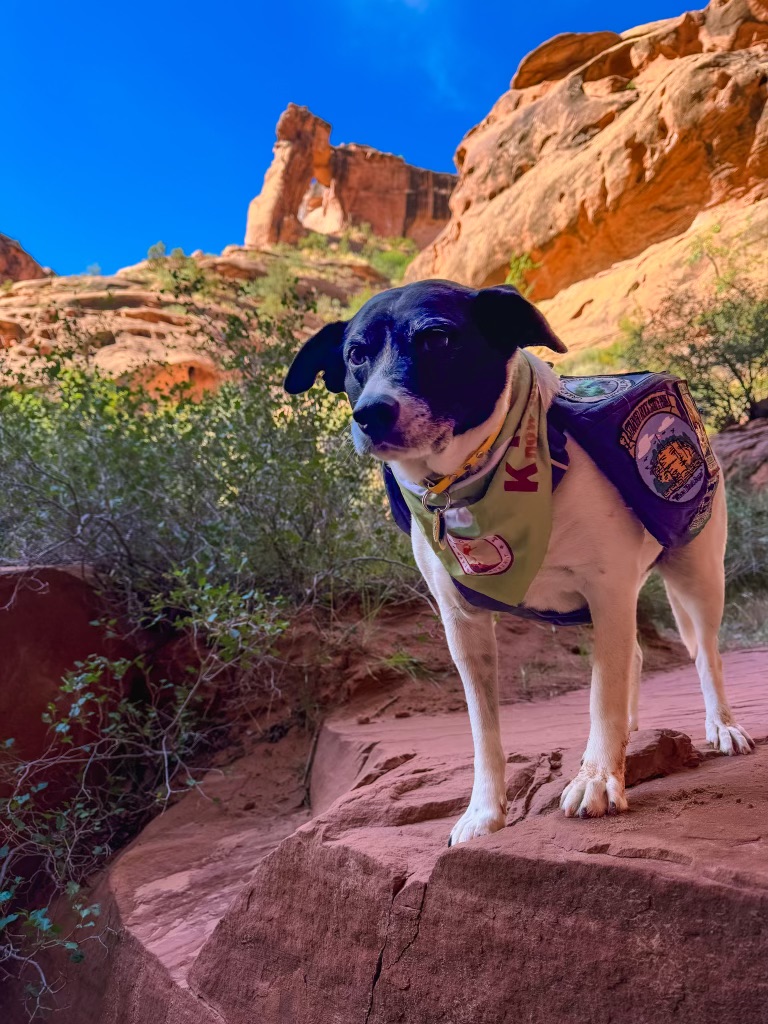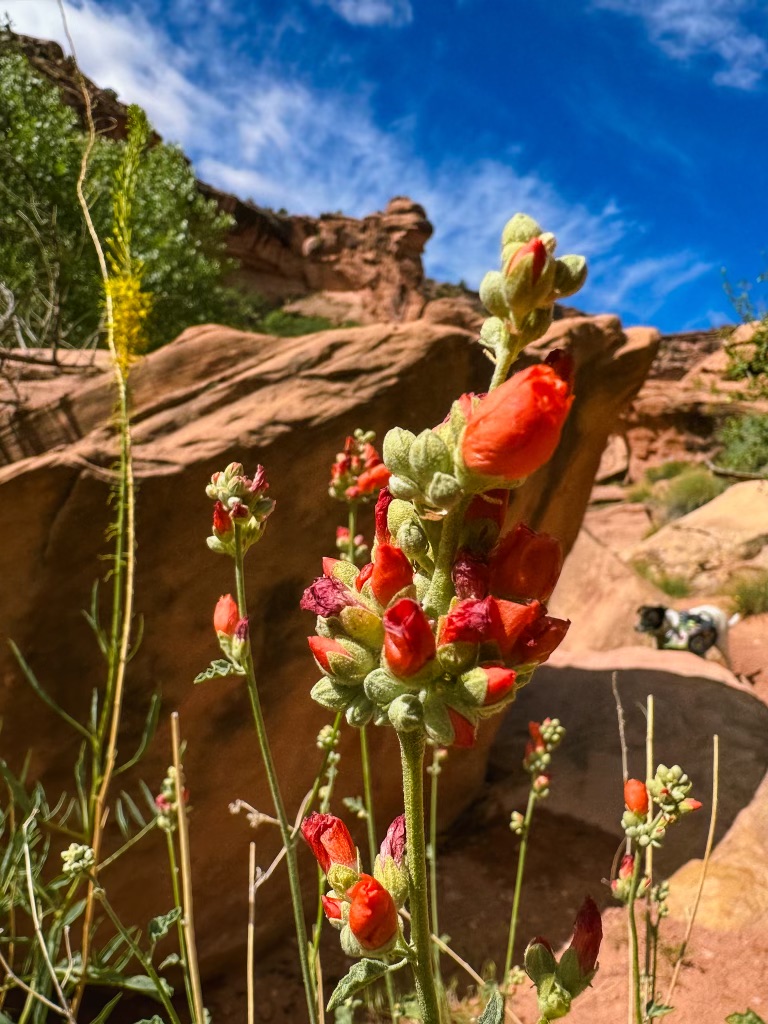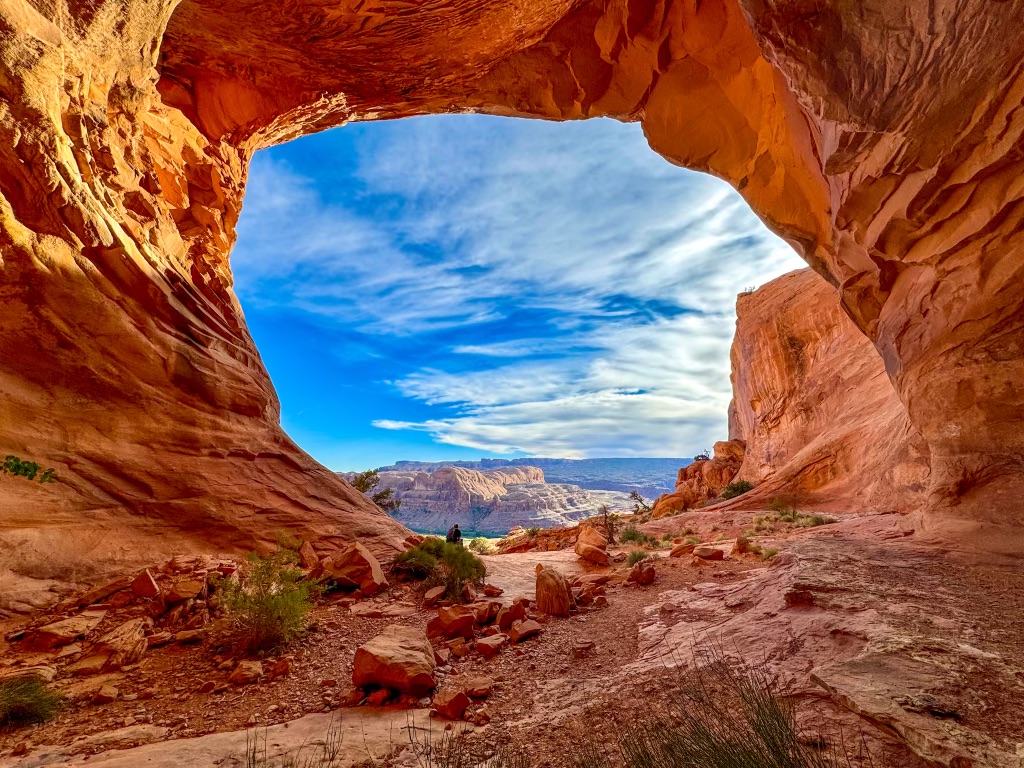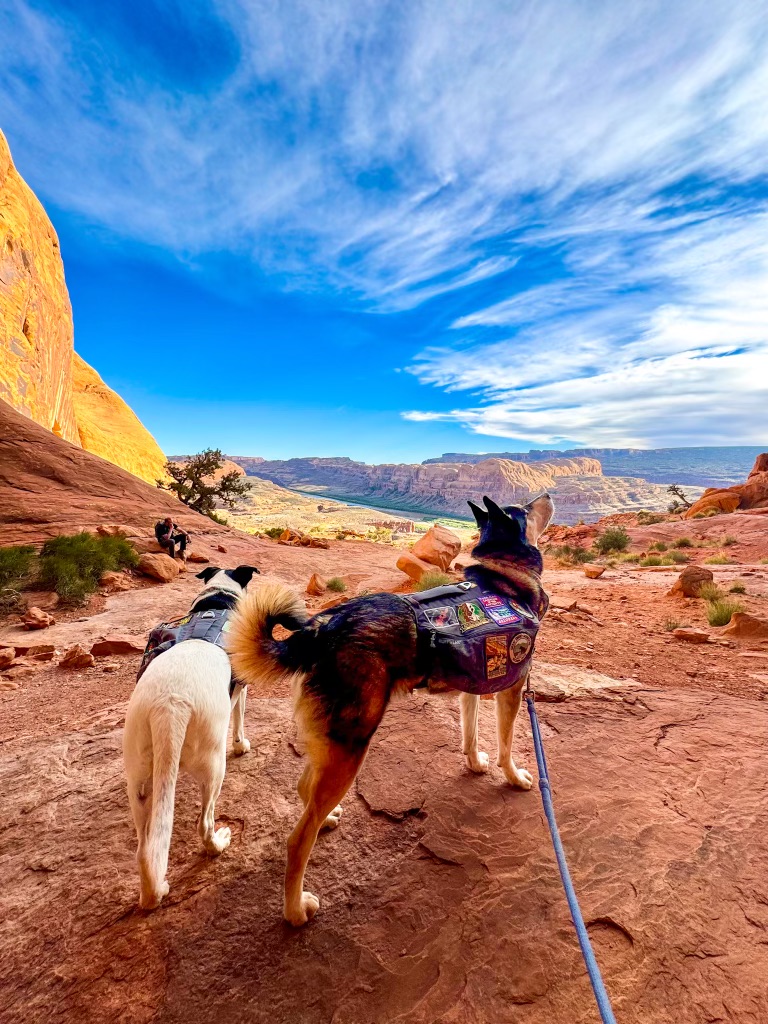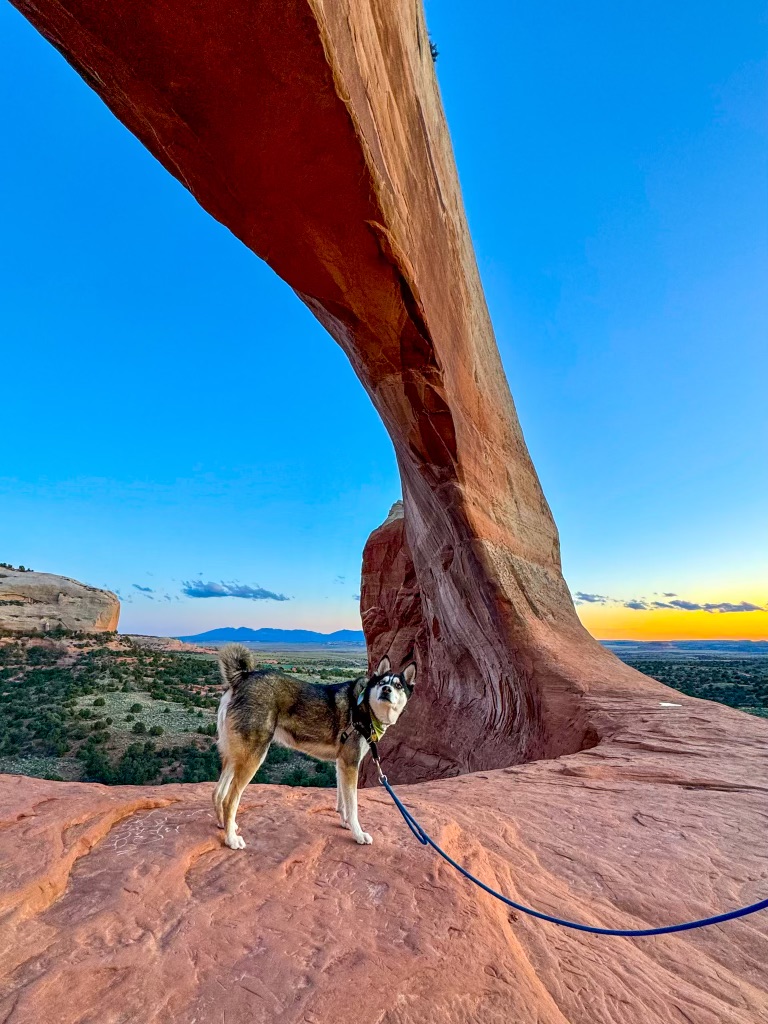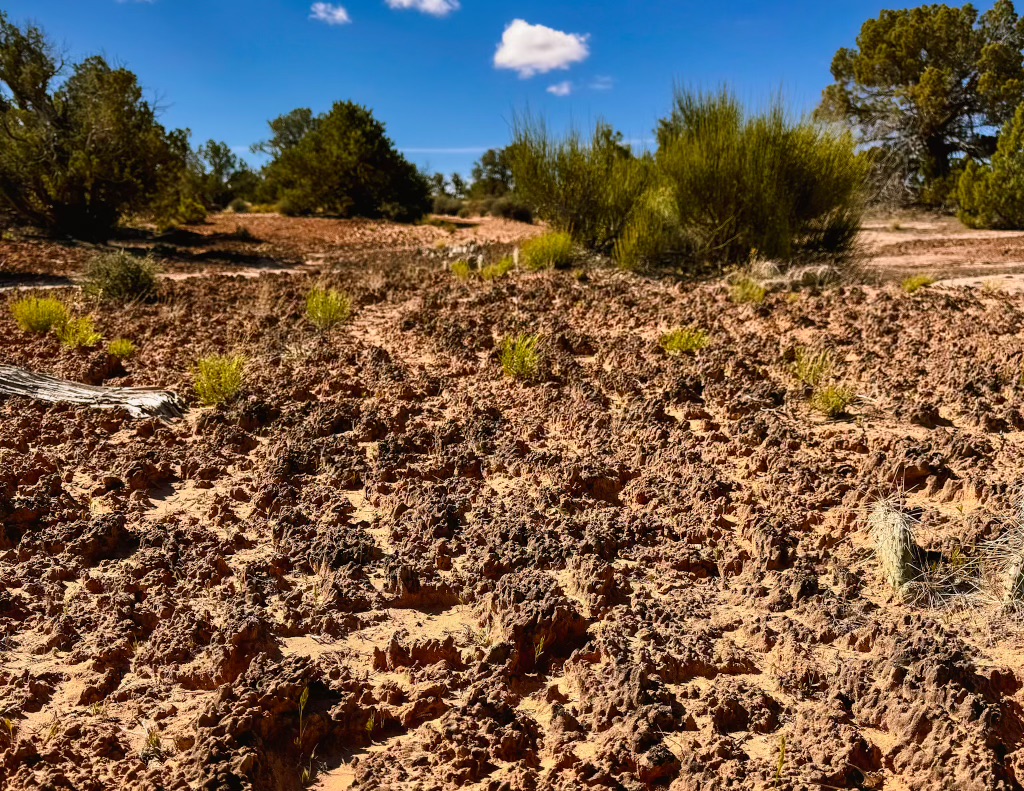Arches National Park and Moab, Utah: Dog-friendly guide
Arches National Park appears on it’s face to be not very dog friendly, and it’s true that dogs can’t hike in the park. However, there are a TON of arch hikes outside the park’s boundaries that your dog can join. When you add those together with scenic drives and hangouts at the dog-friendly spots in the park, you can have an amazing time in the Moab area!
This site contains affiliate links, which means when you click, we may receive a small commission from your purchase at no additional cost to you. This helps us run this page and offer great content free of charge, and we only recommend products that we use and love. We appreciate you!
Introduction: Arches & Moab

Just 4 miles apart from each other, the City of Moab and Arches National Park sit atop the ruddy sandstone terrain of the high desert Colorado Plateau. Southeastern Utah is known as red rock country, the area feels as though you have stepped straight into a surrealist painting. Remarkably unique landscape features, flanked by feats of gravity-defying geology, this place could have easily been conjured in some artist’s wildest imagination.
Arches National Park, Utah, is renowned for its incredible collection of over 2,000 natural stone arches. The park offers visitors a stunning glimpse into the forces of erosion and geological transformation. Towering red rock formations, intricate spires, and sweeping desert vistas create a unique environment that captures the essence of the American Southwest. As you explore the park’s diverse scenery, you’ll discover a rich tapestry of history, ecology, and awe-inspiring beauty that invites both adventure and reflection.
Serving as the gateway town to Arches, Moab, Utah is a lively destination in its own right. Home to some of the most stunning natural landscapes in the American West, this charming town is a hub for outdoor enthusiasts and adventure seekers. With a rich history of Indigenous residents, as well as boom and bust mining settlers common throughout the west, Moab has long served as a place of refuge and resources to human inhabitants. Known for its striking scenery, diverse recreational opportunities, and rich cultural heritage, Moab offers a unique blend of relaxation and excitement.
For the purposes of this post, it’s helpful to think of Moab as the main destination, and Arches National Park as one of several stops on an exploration of the area surrounding Moab. This area has a LOT to offer. Thus, to keep things tidy, this post focuses specifically on opportunities to hike, view, and explore arch formations around this area – both in the park and outside of it. We will likely share more in the future about the plethora of other incredible sights in this area, including other types of rock formations, indigenous cultural sites, overlooks, slot canyons, etc.
This post is all about the arches!
The Way I Fell in Love With Arches & Moab

I’ll never forget the first time I visited Arches National Park. I had just graduated from college, having lived in Colorado for five years at that point, with no desire to point back toward the midwest from which I originated. My outdoor adventures had thus far revolved largely around getting as many alpine ski turns per season as I could, or doing little day hikes in the warm months between ski seasons to keep my mountain legs strong. Sure, I had encountered pictures of the deserts of the American West. My high school textbooks, for example, told highly edited stories of western geography through faded stock photographs of the Grand Canyon, saguaro cactuses, and Utah’s Delicate Arch. I had flipped through coffee table books showing gorgeous, other worldly photographs of Utah’s red rock country, but they felt too exotic, too pristine to really even contemplate. Up to that point, my Midwest-born heart was after everything in Colorado’s Rocky Mountain high country, and very little else.
So the first time I encountered the red desert around Moab, it was not a trip of my own choosing. I had secured a summer job as a camp counselor for the local YMCA. A camp director did all the actual planning, and I was just along for the ride. I was a trip facilitator, pre-teen wrangler, 18 passenger van driver, hiking & climbing instructor, occasional puke cleaner-upper, comforter of the homesick, intervener with middle school behavior, laugher at terrible jokes, and all-around camp mom. It was in this role that I first pulled into a campground at Arches National Park, with a bunch of smelly & excited young adventurers in tow. As we all hopped out of the van, I looked down as my feet sunk into the soft, rust colored sand, and I thought, “Well, this is truly another world.”
On that trip, we took the campers to hike Delicate Arch, Double Arch, Skyline Arch, and more. Together, we all learned the real meaning of hydration as we experienced a level of dryness that makes Colorado feel like a lush jungle. Side-by-side, we travel portal after portal into these magical places that turned our pre-existing notions of beauty on their heads.
The moment I remember most clearly, and is probably the actual reason why I remember this trip so clearly, was one of terror. We were all out on a hike, and counselors were using the typical sandwich method – One adult counselor leads the fastest hikers in front, and one adult counselor stays at the back of the pack with the slowest young explorers. This way, adults are keeping eyes, ears, and spiritual watch over every young person on a particular journey. I was at the back of the sandwich, in charge of keeping the morale of the stragglers high. We were all feeling a little bit on edge because we could see a thunderstorm rolling in, but we still had about a mile to go. We were hiking across a long stretch of slick rock, and there was nowhere to take shelter as the storm inched closer to us. We were focusing solely on speed, when a camper named Carter suddenly stopped. He turned around with wide eyes, and asked, “Lauren, are we safe? Do you think we’re gonna get hit by lightning?” At the moment the question left his lips, I saw his hair standing STRAIGHT up atop his head, as was the hair on my arms. Any seasoned hiker knows that this is a sign of lightning about to strike.
“RUN”, I yelled, as the surroundings turned into a blur, and we all sprinted for the trailhead. Once we were safe, we all had a good (if not extremely nervous) laugh about the fact that if Cameron had not turned to ask me that question at that moment, we all might have gasped our final breaths on those beautiful red rocks.
Despite the terror of that experience (or maybe because of it), for years I thought about getting back to Arches. I had fallen in love with the landscape, but wanted to explore it on my own terms, where I wasn’t focused primarily on the well-being of a group of kids. However, for years I didn’t make the trip back. I passed through the area several times, driving to or from California, or other places on the west coast. I would stop at Milt’s Stop N Eat, or some other Moab dive on the way to or from somewhere. During every pass-through, I would say “I need to get back here soon.”
The Challenge: Dog-Friendly Arches

It wasn’t until May 2024, that I finally decided to make it happen once and for all. Part of why I waited so long to get back to the area is because Arches National Park is known as one of the least dog-friendly national parks, and I’ve always had a furry friend to consider. So when my husband Bryan and I decided to visit this time, I gave myself a challenge – Find and complete as many arch hikes as possible in the Moab area that ARE dog-friendly. I felt certain it would be possible to have an arch-centric experience, without breaking any of the park’s rules. And luckily, it turns out I was right!
I was prepared for the trip to not feel as satisfying as a full visit to Arches National Park, where you don’t have to worry about restrictions due to furry family members. However, I found that the experience was even more transcendent, more satisfying. This approach still allowed exploration of the national park proper, and many of the most notable landmarks that are viewable from the road and from scenic pull out vistas. However, by searching out additional hikes outside the park, we had the opportunity to build a broader relationship with the region.
What follows is our recommendations for visiting this area, and enjoying the sandstone arches with your special furry friends. There are tons of hotels, inns, motels, campgrounds, RV parks, and airbnbs in/around Moab that welcome dogs. So you can choose your own adventure in terms of lodging. And once you have a home base, you can try out all the adventures this area has to offer without leaving your special four-legged friend behind.
Enjoy! And never forget to watch out for lightning.
Land Acknowledgement

Moab, Utah, and Arches National Park, is located on the ancestral homelands of the Núu-agha-tʉvʉ-pʉ̱ (Ute), Timpanogos, & Diné Bikéyah people
To show respect to the native peoples who cared for these lands long before white settlers, we do several things:
- Research and speak the names of the traditional guardians of the land. We use Nativeland.net
- Ask permission from the land itself before we enter. It might seem silly at first, but the more this becomes a habit, the more you become attuned to the ways in which the land speaks.
- Make donations to native-led organizations that support the communities whose ancestral lands were stolen.
Dog-Friendly Stuff In Arches National Park
The Money Stuff
Park Admission Fees
- Day Admission: $30/vehicle
- Annual National Parks Pass: $80 (Covers 1 vehicle or 4 walk-ins per park entrance)
National Park Entrances get pricey if you pay park by park, but we cannot purchasing an annual pass highly enough! An America the Beautiful Pass covers national park entrance fees, but SO MUCH MORE Covers entrance fees and standard amenity (day-use) fees at lands managed by: US Army of Corps of Engineers, National Park Service, US Fish & Wildlife Service, US Forest Service, Bureau of Land Management, & Bureau of Reclamation. You will be shocked how often this pass saves you a few bucks on parking if you are at all a regular hiker!
Timed Entry Reservations
One of the most popular National Park in the US, has a timed entry reservation system in effect from April 1 to October 31. So if you plan to visit during these months, the first step is to purchase this, and you can do so here.
Arches National Park’s Pet Policy
From the Arches National Park website:
Pets are not allowed:
- On any hiking trails, or anywhere off-trail, even while in a carrier
- At any overlooks
- In the visitor center or any building
Where Can I Take my Pet?
Leashed pets may accompany you in the following areas:
- Along established roads or in parking areas
- In established campgrounds and picnic areas
Pet Regulations
- Pets must be leashed at all times.
- Leashes must be 6 feet (1.8 meters) long or less.
- Pets may not make excessive noise that impacts visitors or wildlife.
- Pet excrement must be immediately collected by the pet handler and disposed of in the nearest trash receptacle.
- Leaving a pet unattended and tied to an object (other than your own parked vehicle) is prohibited.
- Pets may not be led by a leash from a bicycle or vehicle.
- Pets may not be left unattended in vehicles if it creates a danger to the animal or if the animal becomes a public nuisance. Cars heat up quickly. When air temperatures exceed 65°F/18°C, a pet in a vehicle may die—even with the windows cracked.
Our Strategy for Visiting Arches with Dogs
Visiting the park with your dog simply takes a bit of a mindset shift. You’re not going to be able to do those iconic hikes like Delicate Arch. But there are plenty of arch hikes you can do with your dog right outside the park’s boundaries, that will still get you some amazing scenery and epic views. Further, your dog can join you on scenic drives, picnic areas, and on paved roadways in the park.
We like to do a scenic drive through the length of the park with the pups in the car, because there is SO much to see from the road. We like to bring a snack or meal, and choose at least one picnic area to stop at with the pupper gals and hang out. Additionally, we let them hop out and walk/sniff around at some of the larger parking areas.
Using this strategy, I think it’s possible to see the best of the park in a half day, then use the rest of your time to explore the outside-park arches listed below. Alternatively, because the park entrance is so close to Moab, it’s possible to pop in and out of the park for picnics or smaller bits of scenic driving throughout your trip.
We love to listen to an audio tour while driving through the park, so we can learn about the geological and cultural perspectives on the various formations & viewpoints in the park. There are many to choose from, but we love this one!
Things To Do in the Park with Dogs
Parking Areas with Large Sidewalk Areas for Walk/Sniff Breaks
- Windows Parking
- Delicate Arch Road Viewpoint Parking
- Devil’s Garden Picnic & Campground Parking
Picnic Areas
- Arches Visitor Center
- Across the road from Balanced Rock
- Panorama Point
- Delicate Arch Viewpoint
- Devils Garden
Dog-Friendly Arch Hikes (Outside the Park)
Related Post: Hiking with your Dog: 12 Tips to Always be Pup-Pared
1. Jewell Tibbetts Arch
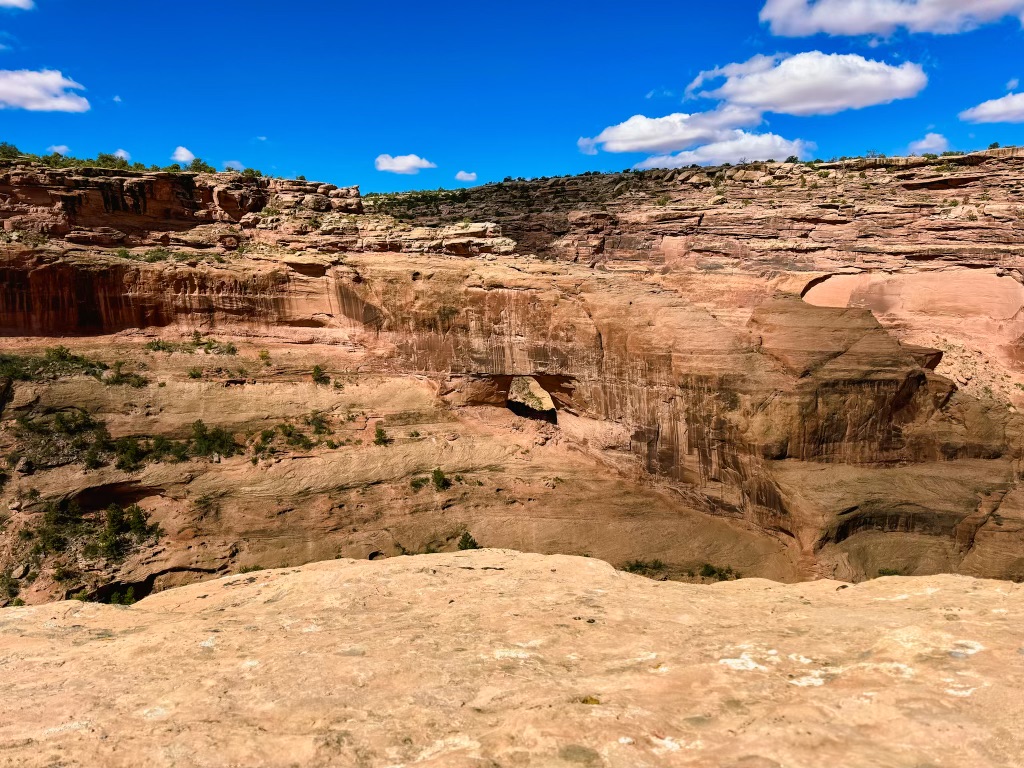
This is a simple desert traipse with a payoff in epic views! It’s fun because it’s so remote. The arch is viewable from a stunning cliffside, and is a more in-the-distance view than some of the other arches you can hike right up and under. But it’s a stunning trail, and you won’t be sorry you made the journey.
Who was Jewell Tibbetts?
Jewell was the wife of Bill Tibbetts, an outlaw in his early years, but assimilated into law-abiding Moab life in his later ones. Like many women, Jewell’s story is not robust in the historical record, but I did find this awesome excerpt from Canyon Country Zephyr:
Jewel got sick in the late 1940s and almost died. She had major surgery and the doctors thought they had lost her for a while. But she came back stronger than ever. Jewel was physically weak for a time, but something happened to her during her near-death experience that made her more spiritual. Those close to her considered her psychic. She amazed her family several times with predictions that came true. The doctors told Jewel that she had to walk to regain her strength….[Bill] began to walk with her, and together they hiked many hundreds of miles. As they walked, they picked up pretty rocks and fossils and soon it became an obsession with them. They became avid rockhounds. Jewel grew strong with her daily hikes in the desert and soon she was restored to full health.
-Jim Stiles, Canyon County Zephyr
Trailhead: Jewell Tibbetts Arch Trailhead
- Length: 1.5 mi roundtrip
- Elevation Gain: 104 ft
- Cost: FREE
- Trail Info on AllTrails
- Important: The road to the trailhead is a narrow sand/dirt lane that becomes rocky about a mile from the trailhead. I didn’t find that high clearance was needed until about .2 mi from the trailhead. But if you’re nervous, you can park right when the rocky driving starts, and just add a couple miles RT to your hike.
2. Hunter Arch & Curious Arch

This hike is pure magnificence! It really has it all. A gorgeous hike through a canyon, with plenty of water for the pups to romp in. You get to see two arches along the way, and the whole path is framed with wildflowers. It’s a great option for a summer hike if you hit the area early or late when the canyon is shady.
As you hike through the canyon, you first come upon a view of Hunter Arch high up on the canyonside. Then, at the end of the trail, you can see Curious Arch in the distance. You can’t get up close and personal with either arch from the trail, but the views are spectacular.
Trailhead: Hunter Canyon Trail
- Length: 3.7 mi roundtrip
- Elevation Gain: 387 ft
- Cost: FREE
- Trail Info on Alltrails
- Note: The dirt road in gets a little rough, but no high clearance needed. Just take it slow.
3. Pinto Arch

This is a gorgeous trail over slick rock, up to a beautiful arch that you can climb inside and under. As you look out, you are treated to views of the surrounding buttes and Colorado River. The girls loved romping around this super fun spot!
Note: there are two additional arches that can be accessed from this trailhead, Corona arch and Bowtie arch. The AllTrails reviews say that the scramble to get up to these is difficult for dogs, so we didn’t try those when we visited, but it didn’t seem impossible. So just know your dog if you’re going to try for all three.
Trailhead: Corona Arch Trailhead
- Length: 1.9 mi roundtrip
- Elevation Gain: 492 ft
- Cost: FREE
- Trail Info on Alltrails
4. Longbow Arch

This arch is really cool & large, but nestled right up against a cliff so it’s almost hidden until right when you come upon it. You can climb right up underneath it and admire all the angles. It’s also perched up on a cliffside, so the air sniffs are spectacular for puppers!
The beginning of this trail is a bit intimidating. You wind up some steep switchbacks that are pretty exposed if you’re scared of heights. Then you get to a pretty good scramble right at the beginning, with wire hand holds anchored into the rock. I had no problem letting Ada scramble up first, then I followed her carefully.
Once you get to the top of the scramble, however, it’s a gorgeous walk over slick rock and sand to reach the arch. And the surrounding views throughout are fantastic!
TrailHead: Longbow Arch Trailhead via Poison Spider Parking Lot
- Length: 2.2 mi roundtrip
- Elevation Gain: 439 ft
- Cost: Free
- Trail Info on Alltrails
5. Wilson Arch

This is a striking arch, accessible right off hwy 191, which makes it a popular destination, and for good reason! You can hike right up and under it, and take in the 360 views. It’s truly a spectacular arch, and an incredible place to sit facing west when the sun goes down.
Due to the super short hike, and proximity to Looking Glass Arch, these two are great to pair during the same outing.
Trailhead: Wilson Arch
- Length: 0.4 mi roundtrip
- Elevation Gain: 95 ft
- Cost: FREE
- Trail Info on Alltrails
6. Looking Glass Arch

This arch requires very little hike, but is off the beaten path. It requires a little drive down a dirt road, but no special vehicle is needed. We had the place to ourselves when we visited. You can hike all around the large rock, and up and under the arch itself.
Due to the super short hike, and proximity to Wilson Arch, these two are great to pair during the same outing.
Trailhead: Looking Glass Arch Interpretive Site
- Length: 0.5 mi roundtrip
- Elevation Gain: 50 ft
- Cost: FREE
- Trail Info on Alltrails
Important Desert Hiking Info
Cryptobiotic Soil
The desert is filled with cryptobiotic soil crusts, identifiable by their bumpy, dark-colored, and spongy appearance. Study the photos, and learn how to identify it, because it’s very important to protect!
Biological soil crusts are a delicate top layer created by a variety of living organisms like algae, Cyanobacteria, and fungi. The organisms grow, photosynthesize, and establish connections that bind together soil particles into an interconnected web of matter. This crust is an important way that desert environments resist erosion, and also provide vital nutrients to nearby plants in a sparse environment.
Soil crusts are also quite fragile. Just the slightest disturbance or bit of pressure can break them, thereby eradicating all of the important benefits. Further, it’s extremely difficult for the crust to repair itself. Even small disturbances can take 5-7 years to grow back, and up to 250 years to recover the benefits.
Thus, it’s EXTREMELY important to stay on trail in desert environments, and do everything in your power to prevent disturbance to the cryptobiotic soil crusts you might encounter. This includes being extra vigilant about where your pupper steps, and goes potty.
Rock Cairns
Desert hikes are often filled with rock stacks, referred to as cairns. On slickrock surfaces, or landscapes devoid of plant cover or formal trail-making materials, cairns serve the very special purpose of marking trails.

It’s super important never to move or alter cairns you encounter on desert hikes.
Hydration
Desert environments are notoriously harsh, and extremely easy to underestimate. The standard rule of thumb for any hike is to carry 1 L of water per hour of hiking. In the desert, you should double this amount, and allow yourself to drink whenever thirsty.
For dogs, the amount of water you bring will depend on their size & stamina, but for my two medium sized dogs, I bring half the amount I bring for myself, and offer them drinks whenever I stop to drink myself.
It’s important to follow these standards no matter the time of year. While water seems less necessary in cooler weather, it’s actually just as important, especially in the desert!
Pet Boarding & Sitting
There are a number of options for boarding if you do want to take a day to hike inside Arches National Park without your dog. We don’t have personal experience with any, because we’ve never done this. But you can google either “pet boarding Moab”, and read reviews to find somewhere you feel comfortable with.
Packing List for Arches National Park & Moab
- AllTrails Pro account
- America The Beautiful National Parks Annual Pass
- Doggo backpack for packing out poop on hikes
- Pupper water bottles
- Human water bottles and plenty of water!
- Poop bags
- Sturdy human hiking shoes
- Rain jacket and/or insulated jacket for high elevation










